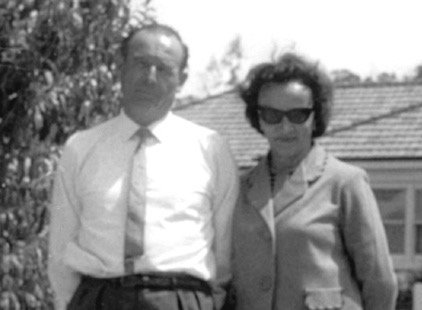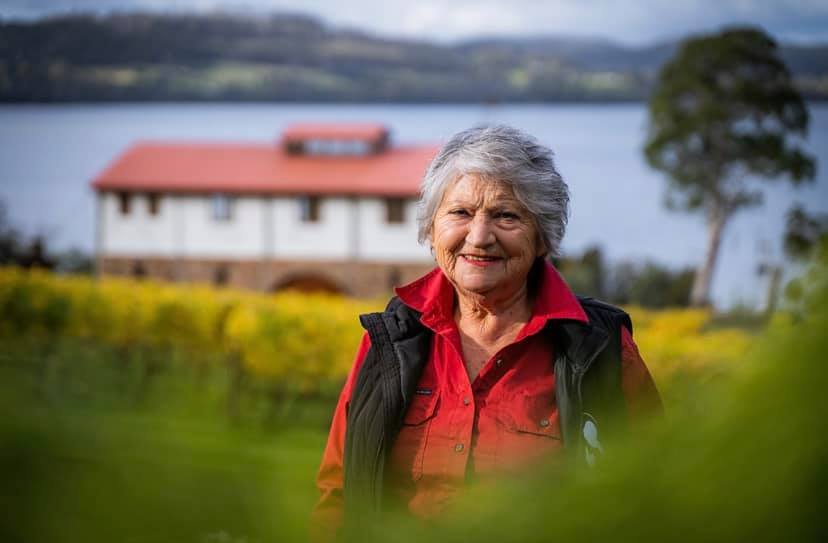
Life Membership is an honour bestowed to members who have rendered special invaluable services to the organisation well beyond that of a typical member.
LIFE MEMBERS
josef chromy
Joe’s is one of the most incredible stories of the wine route. Fleeing his native Czechoslovakia after eleven years of Soviet and Nazi occupation, Josef Chromy arrived in Australia as a penniless immigrant in the 1950s. Using his skills as a Master Butcher and knowledge of European charcuterie, he spent the next forty years building a business, BlueRibbon Meat Products, into one of Tasmania’s leading brands.
After the company was floated on the Australian Stock Exchange in 1993, Josef invested in Tasmania’s fledgling wine industry. He has owned and developed some of Tasmania’s leading wineries including Rochecombe (now Bay of Fires), Jansz, Heemskerk and TamarRidge. In 2007, Joe launched Josef Chromy Wines, building and developing the vineyard at Relbia and establishing his own name brand as a standout winemaking identity in the Tasmanian and Australian wine industry, winner of multiple trophies and medals, including the remarkable World’s Best Chardonnay. The many accolades Josef personally has won including the National Export Hero Award of 2009 and the Tasmanian Award for outstanding services to the Tasmanian wine industry in 2011.
rob cuthbert and mary dufour
Iron Pot Bay Vineyard was established by Roderick Cuthbert and Kyra Hinman in 1988. A great innovator, Rod used his engineering background to solve problems in the vineyard for himself and the industry, winning awards for his innovation. The huge industrial fans he imported from Melbourne to tackle frosts, which were set up below neighbouring vineyard Holm Oak, created a stream of warm air which made the entire Rowella area almost frost-free.
While Rod was in charge of machinery and innovation, Kyra was in charge of vineyard operations. Without her inspiration and drive, the vineyard and its wines would not have established their early reputation, becoming especially well-known as a pioneer of unwooded Chardonnay in the state. Kyra died in 1995.
Rod Cuthbert was a passionate supporter of the wine route, a vocal presence at meetings, and an advocate for strength in numbers. He was even known to go out onto the roads and clean wine route signs. Mary Dufour joined Rod in the management of the vineyard and wine business in 1998 until its sale in 2014. Her upbringing on a farm, a background in teaching, IT and tourism, including time as the Tourism Officer for the West Tamar Council, made her a valuable contributor to the wine route, and Iron Pot Bay. She and Rod established a cellar door at Deviot, a website for the vineyard, and a regular online newsletter.
Rod and Mary retired from viticultural life on the sale of Iron Pot Bay and enjoy retirement in the Northern Midlands. Stories of their legendary Christmas drinks parties still circulate amongst wine route members.
irving fong
Best known to Launceston residents as the owner of the city’s best-known food businesses, Chung Gon Green Grocers, Irving Fong’s story is a long and industrious one. Born in China, he arrived in Tasmania and found work at a market garden at Relbia. Later, he and wife Jennifer purchased the business and operated it successfully for many decades until 1990.
In the mid-1990s, recently widowed, Irving decided that retirement was not for him, and planted 4,000 vines at the Relbia market garden site, at what is now Jinglers Creek Vineyard. These he tended with his second wife Kim, whom he met while studying Viticulture. The vineyard produced its first vintage in 2000, the wines made by industry pioneer Graham Wiltshire, a friend of Irving Fong since 1955. Irving died in 2015 at the age of 83 years.
jEAN & cECILE mIGUET
Jean Francois Miguet, with his wife Annette Cecile (more fondly known as Cecile), came to Tasmania as a contractor for Citra Fougerolles, a French Company contracted to build the Trevallyn Dam and Power station. When the contract was completed, Jean & Cecile decided to stay in Tasmania, and Jean, always accompanied by his soil thermometer, set out to buy a property suitable for a vineyard. In 1955, they leased a six-acre property at Lalla; in 1963, they purchased the land.
Jean & Cecile called the property La Provence, and Jean began planting vines experimentally, some purchased from local nurseries and some propagated from cuttings. There was a Rhododendron Nursery with biosecurity approval across the road, so Jean was able to bring in grapevine material with full nursery evaluation before planting.
Jean and Cecile Miguet have the distinction of being Tasmania’s first vignerons of the modern era, planting wine grapes at Lalla in 1956, and doing what Jean’s family had been doing for five generations – growing grapes to make wine. In the early 1960s, Jean Miguet was ahead of his time as the first modern-day vineyard in the State trying to get a licence to sell wine. Jean Miguet had extraordinary determination. Locally known as Johnny, he is still talked about with respect and admiration by the older locals who remember him.
dr andrew pirie am
Andrew Pirie is one of Tasmania’s founding winemakers and an influential figure in the Tasmanian wine industry, initiating and building some of the island’s most significant brands including Pipers Brook Vineyard and Ninth Island in the mid-1970s.
Andrew launched Tasmania onto the world wine stage with fanfare when his inaugural 1994 Ninth Island Chardonnay took out the white wine trophy at the London International Wine Challenge. Today Andrew nurtures his distinguished single vineyard APOGEE Tasmania near Lebrina where he handcrafts a prestige portfolio of just four wines–two traditional method sparkling – APOGEE Deluxe Vintage Brut and APOGEE Deluxe Vintage Rosé, and table wines–APOGEE Pinot Noir and APOGEE Pinot Gris.
Cellar door tastings are intimate and sometimes may involve a disgorging session and chats about terroir and Lebrina’s remarkable similarity to Champagne. Andrew’s early viticultural research earmarked this potential back in the mid-seventies, an extension of his original exploration of terroir and climate. He continues to be involved in viticultural research and consults on industry development and vineyard management.
brenda radbone
Before coming to live in the East Tamar at Providence Vineyards, Brenda Radbone had no experience of viticulture, vineyards, or the wine industry. Despite this, a former teacher and banker, she turned her hand to running the cellar door at Providence and helping in the vineyard during winter pruning.
Brenda also served as the longest-running Secretary for the wine route, from 2002 to 2014. It was a period of significant growth, with membership numbers growing to over thirty, and the development of many initiatives which would take the Tamar region’s brand and Tasmanian wine generally to the broader market. As Secretary and often behind a stall or table in person, Brenda was involved with many such initiatives, including Taste of the Tamar events in Hobart and Melbourne, annual presentation dinners and the awarding of Life Membership and other awards, and the facilitation of the Tamar Valley Wine Route Trophy in the Canberra International Riesling Challenge. Brenda was awarded Life Membership for her contribution as Secretary for over a decade, and her generous contribution during this time.
“Incredible Individuals Shaping The Tamar Valley ”
dallas and richard richardson
Delamere is one of the original vineyards planted in the Pipers Brook region established in 1982 by Richard and Dallas Richardson.
The fertile soils on the property had previously supported a successful fruit orchard and market garden. It was the pioneering vision of the Richardsons which saw the more elevated areas of the property planted out to the classic and cool climate cultivars of pinot noir and chardonnay. Today the vineyard continues to produce exceptional single-vineyard sparkling and table wines.
Dallas Richardson has been practising printmaking for a number of years. Her work depicting the land and river-scapes of the Tamar Valley is included in the collection of the Tasmanian Museum and Art Gallery.
mike sharman
The Sharmans Vineyard was established by Mike and Philippa Sharman in the 1980s and quickly built a strong reputation. Mike Sharman was a pioneer of the Relbia area, seeing the potential for premium wine production.
Mike and Phillipa bought the Sharmans property in 1985 and experimental plantings were undertaken in 1987. The first vintage Pinot Noir in 1991 won a gold medal and the trophy at the Tasmanian Wine Show, bearing out Mike’s belief in the area, which has since gone on to produce award-winning wines for both Sharmans and other major wineries.
After a long career as a Senior Veterinarian with the Department of Agriculture, Mike completed a degree in Applied Science at Charles Sturt University. He was a great supporter of the Wine Industry Training Program in Tasmania and made wine from the TAFE vineyard at Allenvale for several years.
Mike used to say that going to work in the vines each day felt like going on holiday.
mARION & mARK sEMMENS
Marion wasn’t always Marion & Marions Vineyard was not always Marions Vineyard.
Marion was born in Cyprus where her family grew grapes and her mother Anna was a distiller and tender of the grapes. In 1968 Marion set off on a cruise ship to California, where she met Mark, and they had a shipboard romance.
Years later during a visit home to Australia to visit Marions Parents, Mark & Marion took a childless mini break to Tasmania and fell in love with a rundown apple orchard on 14 hectares in the West Tamar. Within 6 months the San Fransician home was sold, the family packed up and their journey to Tasmania began.
Marions Vineyard was the location for many firsts, the first festival, the first Taste, the first Wedding and the first Jazz Concert. It was the place for many parties, all of which Marion cooked for.
Mark Semmens passed away in 2022, and Marion is still incredibly involved, she runs the cellar door 6 days a week, and runs the vineyard with her family, keeping an eye on everything at Marions.
DR BERTEL AND ANNE SUNSTRUP, JILL MITCHELL
Dr Bertel and Anne Sundstrup established Dalrymple Vineyards in the mid-1980s along with Anne’s sister Jill Mitchell. Described as visionaries, the Sundstrups travelled to France for inspiration and guidance.
Returning to Tasmania, they established Dalrymple in the heart of the highly acclaimed Pipers River region, in what was to become the ‘sparkling corner’ of the north eastern Tamar region. The grapes from their vineyard continue to be made into some of Australia’s most distinctive, award-winning wines.
Bert and Anne were medical practitioners as well as vineyard owners, Anne a registered nurse, and Bertel a doctor, and head of the radiotherapy oncology unit at Launceston General Hospital for almost three decades. He is remembered by colleagues as a ‘wonderfully entertaining, witty and generous man.’ Together the couple had three children.
Jill Mitchell worked at cellar doors in the north-eastern Tamar and was renowned for the warmth of her welcome, once described by Australian Traveller as able to bring a smile to even the grumpiest of traveller’s faces!
rod and karen thorpe
The vineyard at Moores Hill was planted in 1997 by Rod and Karen Thorpe on farmland they had purchased twenty years earlier. After pulling out an old vineyard, they planted and established new vines, and ran the new vineyard until 2008. Rod had become interested in viticulture when working at Waterton Estate with five other Lions members.
The site was seen by many as a perfect vineyard site, on a northern slope with Bass Strait breezes and a micro-climate making it a prime spot for Riesling, Chardonnay, Pinot Noir, Cabernet Sauvignon and Merlot. They won a gold medal in 2000 for Riesling, along with many other medals.
Rod worked with the new owners in the vineyard for the first 18 months of their ownership, assisting with picking, pruning and operations, and was said to be as effective as not one man but three. Together, he and Karen are credited for building Moore’s Hill to be an estate producing vines of consistently high quality – and prize-winning wines.
During the Thorpe’s time at Moores Hill, many functions were held there for the wine route as well as the vineyard business. Rod’s passion for viticulture persists, as he is currently working at another Tamar Valley Wine Route vineyard, helping new owners extend their vines as it was an experimental vineyard from 1966.
The Thorpe’s are continuing to try out different methods for the future of viticulture.
GRAHAM WILTSHIRE OAM
A pioneering wine producer, Graham Wiltshire established the Heemskerk pilot vineyard at Legana in 1966, with the first commercial release of Heemskerk Cabernet Sauvignon in 1976. In the eighties, his winemaking moved to Heemskerk at Pipers Brook, where he developed Jansz, Tasmania’s first sparkling wine. His joint venture with French champagne house, Louis Roederer in 1985 was the foundation of the State’s modern sparkling wine tradition, and he championed pinot noir and sparkling wine production in Tasmania. His vines at Legana are still under production under the ownership of Velo Vineyards.
Graham was instrumental in forming the Pinot Noir Tasmania Forum in the late 1990s, was a Life Member of the Australian Wine Industry, was awarded an OAM and won the Royal Agricultural Society’s Tasmanian Award. He was described by friend and colleague Robert Heazelwood as ‘a Francophile wine lover with a liking for berets and a wit as dry as a good sauvignon blanc’. Graham died in 2014 at 82 years of age.














